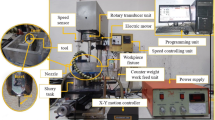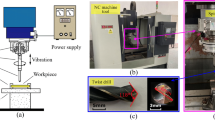Abstract
Tool wear in micro-manufacturing process is of paramount importance to meet stringent design requirements of workpiece in a cost-effective manner. In present work, tool wear in micro-rotary ultrasonic machining (μ-RUM) has been investigated for Ø300-μm peck drilling operation. Two sets of experiments have been conducted using electroplated hollow diamond tool and borosilicate glass as workpiece to evaluate the effects of μ-RUM parameters on tool wear. In the first set, the effects of tool-based parameters like grain size and thickness of hollow tool have been studied using full factorial design and optimum tool design was obtained. In second set, the effects of process-related parameters like spindle speed, distance traverse in each stroke, table feed rate, vibration amplitude, and vibration frequency on tool wear were studied using central rotatable composite design with optimum tool designed in first step. Analysis of variance has been used to study the significance of μ-RUM factors on tool wear. After investigation and analysis of the data, it has been concluded that thickness and grain size of hollow diamond tool had an inverse effect on tool wear. Tool with 100-μm thickness and 30-μm grain size was best possible tool for minimum tool wear. It has also been found that process parameters like traverse in each stroke, vibration amplitude, vibration frequency, and spindle speed have affected tool wear, but vibration frequency was most influencing process parameter and resulted in rapid tool wear if not selected properly.
Similar content being viewed by others
References
Hu P, Zhang JM, Pei ZJ (2003) Experimental investigation on coolant effects in rotary ultrasonic machining, NSF Workshop on Research Needs in Thermal Aspects of Material Removal Processes, Stillwater, OK, pp. 1–6
Kiran RS Kolluru VSS (2005) Rotary ultrasonic machining—a review, Proceeding of National Aerospace Manufacturing Society, 22–23, pp.105–114
Kumar J, Khamba JS (2009) Investigating the machining characteristics of titanium using ultrasonic machining. A PhD Thesis Thapar University of Patiala
Feng J (2010) Micro grinding of ceramic materials, PhD Thesis University of Michigan
Pei ZJ, Khanna N, Ferreira PM (1995) Rotary ultrasonic machining of structural ceramics: a review. Ceram Eng Sci Proc 16:259–27
Churi N (2010) Rotary ultrasonic machining of hard to machine material, PhD Thesis University of Kansas State
Zeng WM, Li ZC, Pei ZJ, Treadwell C (2005) Experimental observation of tool wear in rotary ultrasonic machining of advanced ceramics. Int J Mach Tools Manuf 45:1468–1473
Qin N (2011) Modelling and experimental investigations on ultrasonic vibration assisted grinding Phd Thesis University of Kansas State
Park WH (2008) Development of micro-grinding mechanics and machine tools, PhD Thesis, Georgia Institute of Technology
www.glidemeiseister.com/de/ultrasonic/Sauer diamond tool catalogue
Montgomery (2001) Design and analysis of experiments. Wiley (Asia), Singapore. DC
Rakesh S, Kiran Kolluru VSS (2009) Micro-hole drilling in Pyrex wafer for high pressure micro valve application. National Conference on Expanding Frontiers in Propulsion Technology ASET
Malkin S (2006) Grinding technology theory and applications of machining with abrasives, Society of Manufacturing (SME) Press
Gong H, Fang FZ, Hu XT (2010) Kinematic view of tool life in rotary ultrasonic side milling of hard and brittle materials. Int J Mach Tools Manuf 50(3):303–307
Lv D, Huang Y, Wang H, Tang Y, Wu X (2013) Improvement effects of vibration on cutting force in rotary ultrasonic machining of BK7 glass. J Mater Process Technol 213(9):1548–1557
Sivasakthivel PS, Vel Murugan V, Sudhakaran R (2010) Prediction of tool wear from machining parameters by response surface methodology in end milling. Int J Eng Sci Technol 2(6):1780–1789
Author information
Authors and Affiliations
Corresponding author
Rights and permissions
About this article
Cite this article
Jain, A.K., Pandey, P.M. Experimental studies on tool wear in μ-RUM process. Int J Adv Manuf Technol 85, 2125–2138 (2016). https://doi.org/10.1007/s00170-015-8248-y
Received:
Accepted:
Published:
Issue Date:
DOI: https://doi.org/10.1007/s00170-015-8248-y




